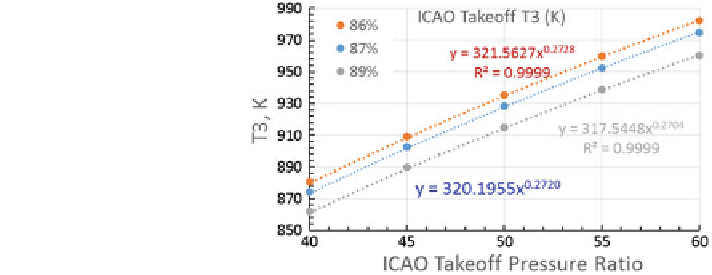Environmental Engineering Reference
In-Depth Information
cation of combustors into four categories (viz. large,
medium, small, and very small sizes) was based on the corrected
In the 1970s, arbitrary classi
flow rates being >5,
>2, between 1 and 2, and less than 1.0 kg/s, respectively. With the increasing takeoff
pressure ratio since the 1990s, these numbers have been coming down but not fast
enough for the medium- and small-size combustors to greatly in
fl
uence the overall
design strategy. However, if we jump to 55 OPR cruise for the single aisle airplanes
(viz. Kumar et al.
2012c
), Wc at takeoff goes down to 1.1 kg/s with attendant small-
size design challenges. Similarly, the future energy-ef
fl
cient large-size engines will
progressively approach the limitations of the medium-size combustors suddenly
subject to takeoff pressure ratio approaching 60. This will impact the durability
characteristics of both the fuel injection systemand the combustion structure requiring
innovations in aerothermal, mechanical, materials, and manufacturing. Let us illus-
trate the impact of P
3
and T
3
as shown in Figs.
19
and
20
; the former is for the sea-level,
standard-day, static SLSS takeoff pressure ratio (also known as ICAO takeoff pressure
ratio) whereas the latter is for a typical hot-day. The two generation of engines (viz.
N + 2 and N + 1 generations) are represented, respectively, by isentropic ef
ciencies
ʷ
isen
of 89 and 87%, whereas 86%
ʷ
isen
represents a fully deterioratedN+ 1 generation
engine. Since the interest here is on
40 OPR engines, the x-axis value starts at 40 and
goes up to 60, hoping that we do not have to deal with >60 OPR engines in the
next 20 years. The empirical
≥
fits for SLSS as shown in Fig.
19
are T
3
;
SSS
¼
5627 OPR
0
:
2728
, respectively, for
the N +2,N + 1, and its deteriorated engines. The corresponding
544 OPR
0
:
2704
1955 OPR
0
:
272
and 321
317
:
320
:
:
;
its for the hot-day,
430 OPR
0
:
2662
2229 OPR
0
:
2679
sea-level takeoff from Fig.
20
are T
3
;
SShot
¼
356
:
359
:
;
6961 OPR
0
:
2688
.
Model-based predictions for ignition delay, flashback, and/or flameholding F
and 360
:
3
are nonexistent at least for practical con
gurations because of the complexity and
lack of information on the hardware details and attendant effects. Therefore, we will
present ignition delay times
˄
ign
calculated by Prof. Chih-Jen Sung by using a most
recent set of detailed kinetic schemes for Jet fuels. Table
5
gives a summary for the
two values of OPR, namely 45 and 60, so that we can see the reduction in
˄
ign
relative to the most recently introduced lean dome engine (viz. GEnx) that has been
in the
field since 2011 without having encountered any incidence of hardware
Fig. 19 Sea-level static (SLS)
standard-day takeoff
combustor inlet temperature
versus ICAO takeoff pressure
ratio for different isentropic
efficiencies

Search WWH ::

Custom Search